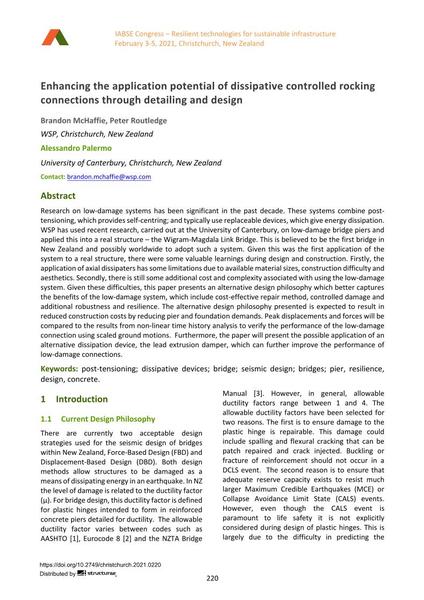Enhancing the application potential of dissipative controlled rocking connections through detailing and design

|
|
|||||||||||
Bibliografische Angaben
| Autor(en): |
Brandon McHaffie
(University of Canterbury, Christchurch, New Zealand)
Peter Routledge (University of Canterbury, Christchurch, New Zealand) Alessandro Palermo (University of Canterbury, Christchurch, New Zealand) |
||||
|---|---|---|---|---|---|
| Medium: | Tagungsbeitrag | ||||
| Sprache(n): | Englisch | ||||
| Tagung: | IABSE Congress: Resilient technologies for sustainable infrastructure, Christchurch, New Zealand, 3-5 February 2021 | ||||
| Veröffentlicht in: | IABSE Congress Christchurch 2020 | ||||
|
|||||
| Seite(n): | 220-228 | ||||
| Anzahl der Seiten (im PDF): | 9 | ||||
| DOI: | 10.2749/christchurch.2021.0220 | ||||
| Abstrakt: |
Research on low-damage systems has been significant in the past decade. These systems combine post- tensioning, which provides self-centring; and typically use replaceable devices, which give energy dissipation. WSP has used recent research, carried out at the University of Canterbury, on low-damage bridge piers and applied this into a real structure – the Wigram-Magdala Link Bridge. This is believed to be the first bridge in New Zealand and possibly worldwide to adopt such a system. Given this was the first application of the system to a real structure, there were some valuable learnings during design and construction. Firstly, the application of axial dissipaters has some limitations due to available material sizes, construction difficulty and aesthetics. Secondly, there is still some additional cost and complexity associated with using the low-damage system. Given these difficulties, this paper presents an alternative design philosophy which better captures the benefits of the low-damage system, which include cost-effective repair method, controlled damage and additional robustness and resilience. The alternative design philosophy presented is expected to result in reduced construction costs by reducing pier and foundation demands. Peak displacements and forces will be compared to the results from non-linear time history analysis to verify the performance of the low-damage connection using scaled ground motions. Furthermore, the paper will present the possible application of an alternative dissipation device, the lead extrusion damper, which can further improve the performance of low-damage connections. |
||||
| Stichwörter: |
Entwurf Beton Brücke Erdbebenbemessung Pfeiler
|
||||
